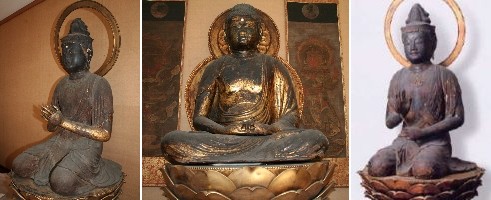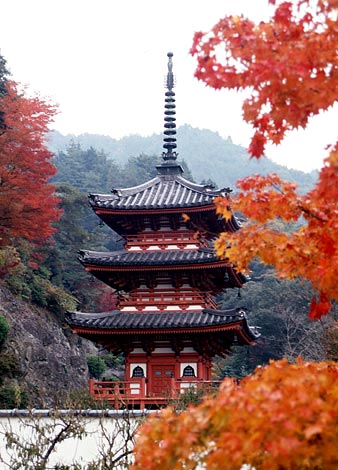
Mimuroto-ji (三室戸寺), translated as “Temple of the Three Rooms,” is a Shingon temple in Uji, Kyoto Prefecture. It is Temple 10 on the Saigoku Kannon 33 Pilgrimage and sits on the slopes of Mt. Myōjōzan above the Uji River. Known affectionately as the “Flower Temple,” Mimuroto-ji is famous for its vast gardens, seasonal blossoms, and long association with imperial patronage and Heian-era literature.
Honzon – Senjū Kannon
The principal image is Senjū Kannon (Thousand-Armed Kannon), carved during the reign of Emperor Kōnin (770–781). The statue is a secret image, revealed only once every 33 years. It is said that each of its many arms, with an eye on every hand, allows Kannon to see and save beings in need.
Over the centuries, additional treasured statues have been enshrined at Mimuroto-ji:

- Amida Triad: A Heian-period grouping of Amida Buddha flanked by Kannon and Seishi. These statues, heritage listed as National Important Cultural Properties, are noted for their rounded Tang-style features and graceful ornamentation.
- Ukifune Kannon: A wooden image linked to the Tale of Genji’s tragic heroine Ukifune, carved in the Heian period. It holds a vase of infinite compassion.
- Bishamonten: The Bodhisattva of War and one of the Seven Lucky Gods. This Heian-era statue of Vaishravana is also believed to heal plagues and is a designated Important Cultural Property.
Things to See at Mimuroto-ji
Mimuroto-ji Gardens
The temple is renowned for its gardens. Visitors enjoy azaleas in May, hydrangeas in June, lotus blossoms in July, and colorful autumn foliage. The carefully landscaped grounds cascade down the hillside with ponds, tea pavilions, and walking paths.
Hondō
The current two-storied Hondō was rebuilt in 1805 after a devastating fire. It has a distinctive irimoya (hip-and-gable) roof, a style introduced from China with early Buddhism. In front of the inner shrine is a Heian-period statue of Shakyamuni Buddha, also a National Important Cultural Property.
Wish-granting Bull
In front of the Hondō stands the “Wish-granting Bull” (hōshō-ushi). Inside its open mouth is a stone sphere said to be a magic jewel. Visitors roll the ball for good luck, especially for healing stomach ailments, though the stone cannot be removed—its presence remains a mystery.
Ema
Behind the bull are racks filled with ema (wooden prayer plaques). Many petitions here are for health and healing, tied to the legend of the bull’s jewel.
Treasure Storehouse
The temple’s Treasure Hall, open monthly on the 17th, preserves important artworks, including the Amida Triad, Ukifune Kannon, and Bishamonten.
Jūhachi Jinja
A small Muromachi-era shrine dedicated to eighteen guardian deities said to have come from Korea with early immigrants. It is heritage listed as a National Important Cultural Property.
Sanjūnotō
The three-storied pagoda, rebuilt in 1805, is especially photogenic in autumn when its vermillion contrasts with scarlet maple leaves.

Amida-dō
East of the Hondō is the Amida-dō, believed to be the resting place of Shinran Shōnin’s father, Lord Hino Arinori. Shinran’s daughter, the nun Kakushin, built the memorial.
48 Vows Plaque
A plaque commemorates the 48 vows of Amida Buddha, made as the bodhisattva Dharmakara, which are central to Pure Land Buddhism.
Ukifune’s “Grave”
Local tradition associates Mimuroto-ji with the Tale of Genji. The character Ukifune, who throws herself into the Uji River, is said to be buried here after being saved by Kannon and later becoming a nun.
Jizō Grove
A grove of small Jizō statues behind the bell tower represents memorials for lost pregnancies. Parents place offerings here, and priests perform rites for the souls of mizuko (“water babies”).
History of Mimuroto-ji
The temple was founded in 770 by Emperor Kōnin after mysterious golden light appeared at the palace, traced to an image of Senjū Kannon revealed in the Uji River’s tributaries. The emperor enshrined the statue and established Mimurot








